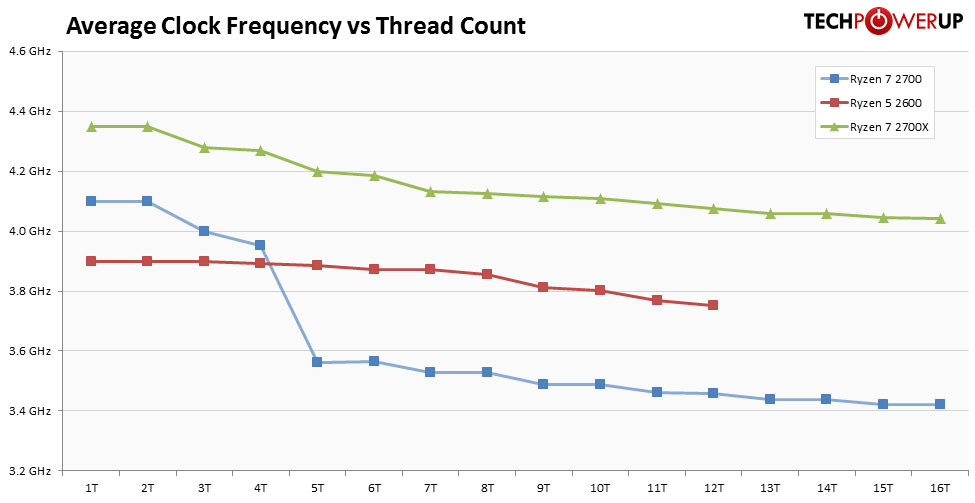 10
10
AMD Ryzen 5 2600 3.4 GHz Review
Power Consumption & Efficiency »Clock Frequencies and Boost Clock Analysis
Most modern processors feature a capability called "Boost" or "Turbo" that automatically overclocks the CPU beyond the nominal clock frequency provided certain conditions related to thread count, power draw, and temperatures are met. Our testing on this page investigates what actual real-life frequencies can be achieved in such scenarios. The data below presents the minimum, maximum, and average clock frequency of a given core/thread-count combination for a typical heavy workload. We start with one thread and go all the way up to the CPU's maximum thread count while at the same time measuring the average clock frequency for these timed testing runs.
The Ryzen 5 2600 can hold its maximum boost clock with up to five threads. The chip's clock speed is unshakable from 3.90 GHz with 1-3 threads. As we approach 4-thread, there's a negligible decay of 8 MHz because this is probably the point at which the processor is deciding on whether to sustain maximum boost clocks or to switch to a lower boost state, because it's not just dealing with our 4-thread load, but some load blips on other cores from background OS tasks that are guiding the decision. This becomes more pronounced as we reach 5-thread, at which point the observed frequency is 3.88 GHz.
As we step up the gas to 6-thread and 7-thread, clock speeds drop by 25 MHz ("Zen" chips have a multiplier granularity of 0.25x), to around 3.875 GHz. The 8-thread load sheds another 25 MHz to around 3.85 GHz. With 9-thread and 10-threads, it sheds yet another 25 MHz to 3.80 GHz, and a drop of another 50 MHz takes place as we reach 11-thread and 12-thread.
When we tested the Ryzen 7 2700 recently, we noticed that its boost clock fell off a cliff beyond 4-thread, by almost 450 MHz, and as we reached its maximum 16-thread state, it lost a stunning 1 GHz of boost clock, staying just 200 MHz above the nominal clock. So we did a comparative analysis:

As you can see, the Ryzen 7 2700 boost clock steadily deteriorates as we increase its multi-threaded load, with a steep fall beyond 4-thread. The Ryzen 5 2600, on the other hand, very gradually loses clock speeds, and in very small amounts (often by 25 MHz, rarely 50 MHz), with almost no steep drops and near-maximum boost sustained until 6-thread, and only a drop by 150 MHz at it maximum 12-threaded workload (compare that to the 1 GHz the Ryzen 7 2700 loses at max workload!).
The only possible explanation is TDP. AMD is positioning the Ryzen 7 2700 and Ryzen 5 2600 as "high efficiency" SKUs and set their TDP at 65 W. The 2700 has two more cores and four more threads than the 2600, and hence, there is an effort to keep its TDP at 65 W, which punishes its boost clock harder. Its clock speed hence drops by a stunning 450 MHz beyond 4-thread, and by 1 GHz at 16-thread. The Ryzen 5 2600 has fewer cores and is hence more comfortable in sustaining its boost clocks.
When not loaded at all, the processor's idle clock is 1550 MHz.
Mar 17th, 2025 09:37 EDT
change timezone
Latest GPU Drivers
New Forum Posts
- HP say: Oops, we did it again ! (22)
- AMD RX 9070 XT & RX 9070 non-XT thread (OC, undervolt, benchmarks, ...) (43)
- Is RX 9070 VRAM temperature regular value or hotspot? (3)
- how to update vga bios for my 5080? (5)
- What's your latest tech purchase? (23341)
- Fan speed locked high - EVGA 2060 sc (4)
- Microcenter GPU Stock status (37)
- UPLOAD BIOS PNY XLR8 RTX 4080 VERTO EPIC-X [Non-OC] and Flash BIOS OC Edition (3)
- PCI 4.0 16x slot reported as a PCI 5.0 8x with the AMD 9070 XT Reaper GPU (34)
- Recommended PhysX card for 5xxx series? [Is vRAM relevant?] (189)
Popular Reviews
- AMD Ryzen 9 9950X3D Review - Great for Gaming and Productivity
- Sapphire Radeon RX 9070 XT Nitro+ Review - Beating NVIDIA
- ASUS GeForce RTX 5090 TUF Review
- MSI GeForce RTX 5070 Gaming Trio OC Review
- VAXEE Zygen NP-01S V2 Wireless Review
- Gigabyte X870E Aorus Pro Review
- XFX Radeon RX 9070 XT Mercury OC Magnetic Air Review
- Kioxia Exceria Plus G4 2 TB Review - Energy-Efficient PCIe Gen 5
- ASUS Radeon RX 9070 TUF OC Review
- Dough Spectrum Black 32 Review
Controversial News Posts
- NVIDIA GeForce RTX 50 Cards Spotted with Missing ROPs, NVIDIA Confirms the Issue, Multiple Vendors Affected (518)
- AMD RDNA 4 and Radeon RX 9070 Series Unveiled: $549 & $599 (260)
- AMD Mentions Sub-$700 Pricing for Radeon RX 9070 GPU Series, Looks Like NV Minus $50 Again (250)
- NVIDIA Investigates GeForce RTX 50 Series "Blackwell" Black Screen and BSOD Issues (244)
- AMD Radeon RX 9070 and 9070 XT Official Performance Metrics Leaked, +42% 4K Performance Over Radeon RX 7900 GRE (195)
- AMD Radeon RX 9070-series Pricing Leaks Courtesy of MicroCenter (158)
- AMD Radeon RX 9070 XT Reportedly Outperforms RTX 5080 Through Undervolting (118)
- Microsoft Introduces Copilot for Gaming (117)